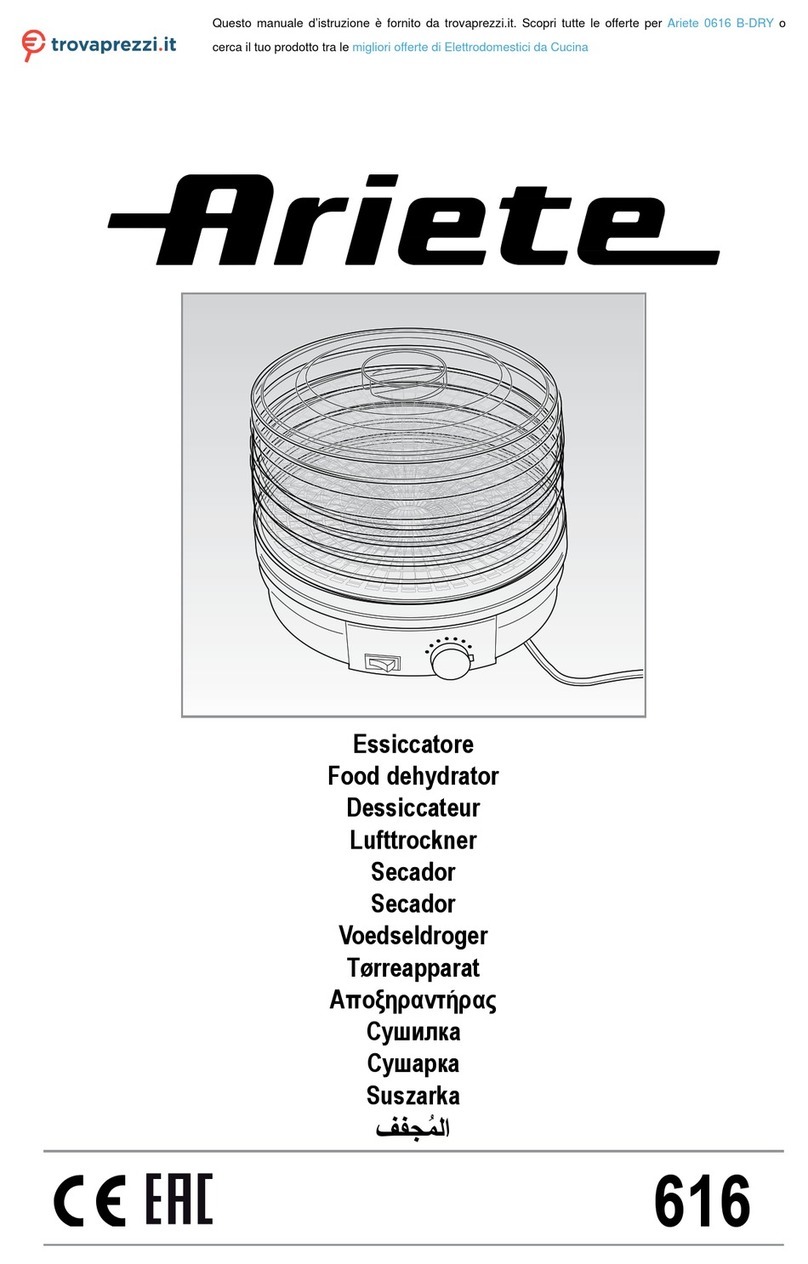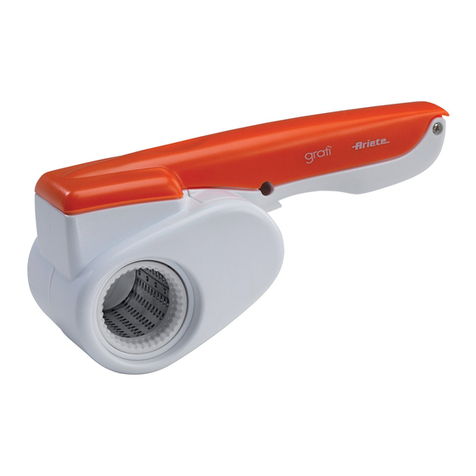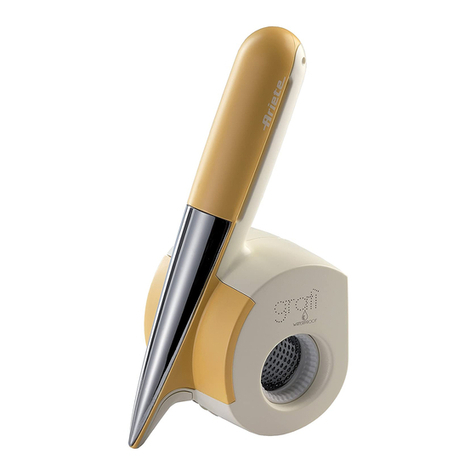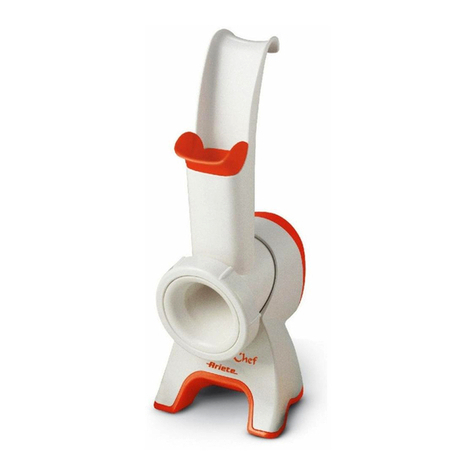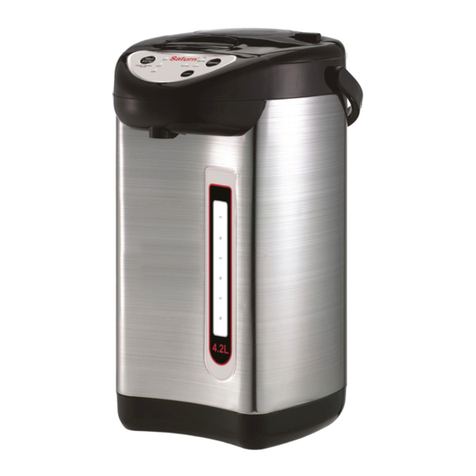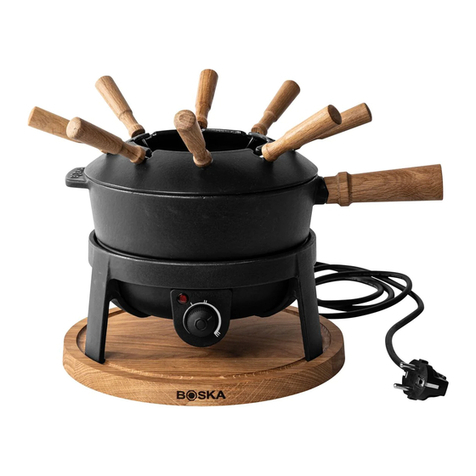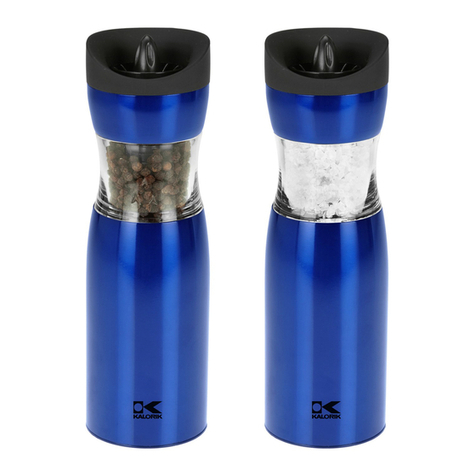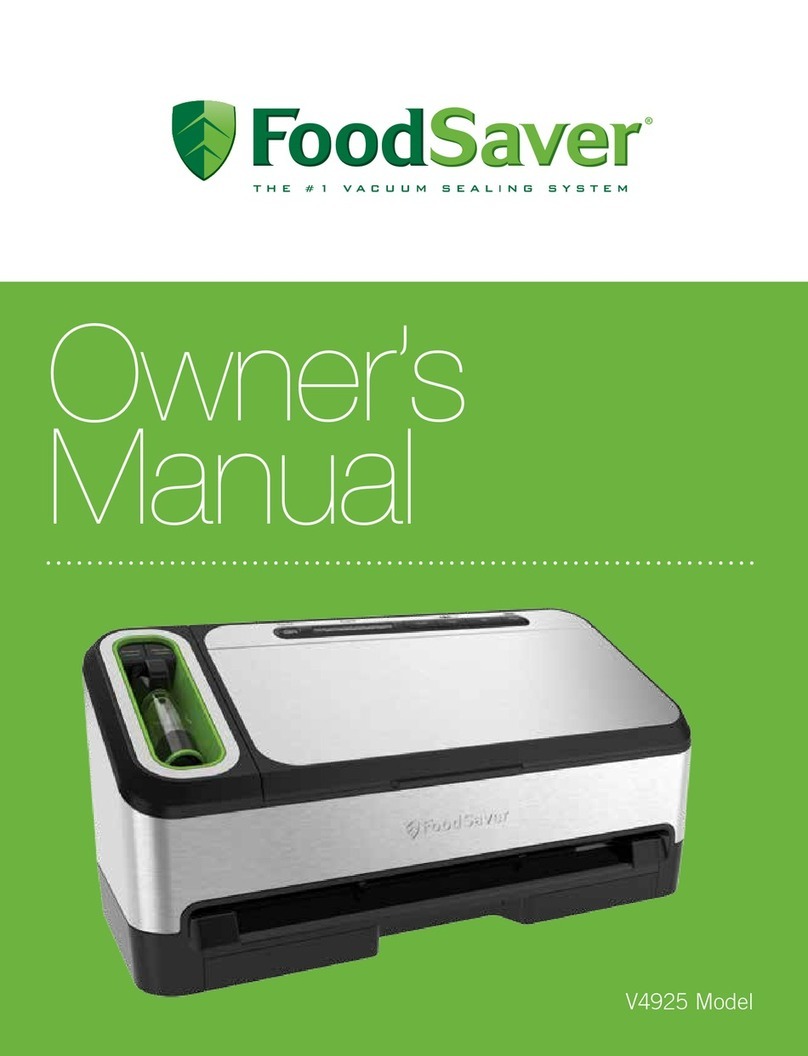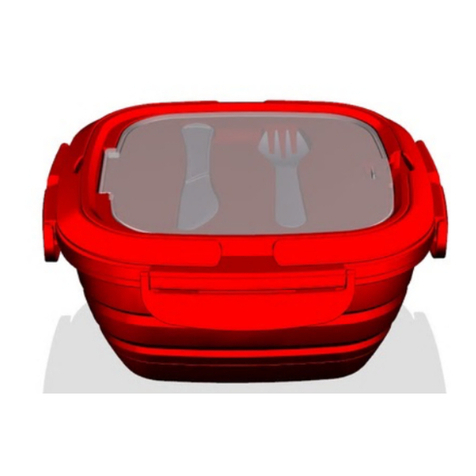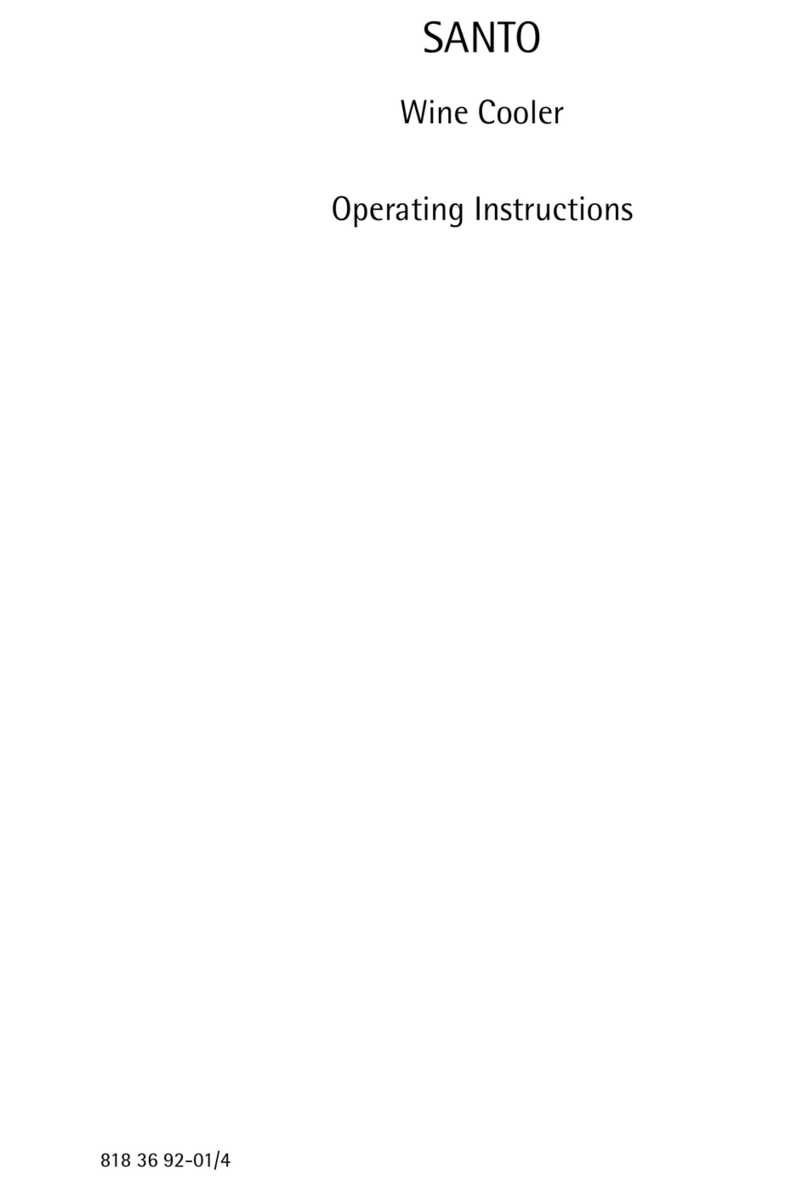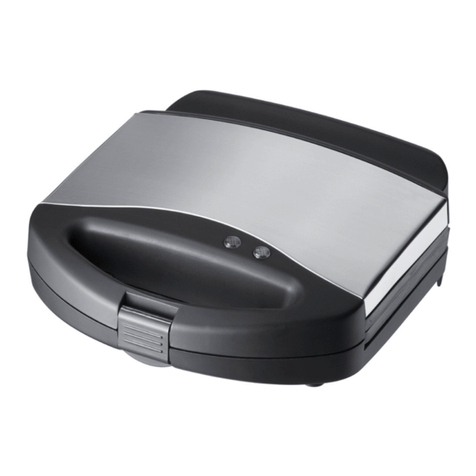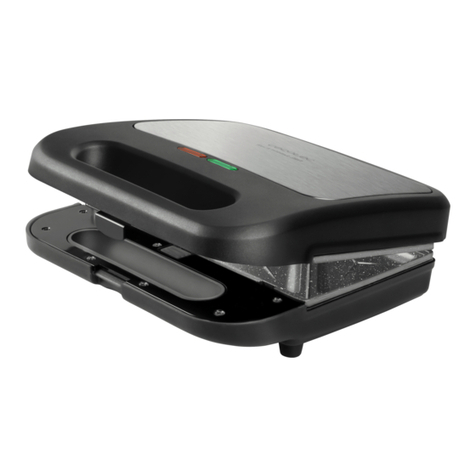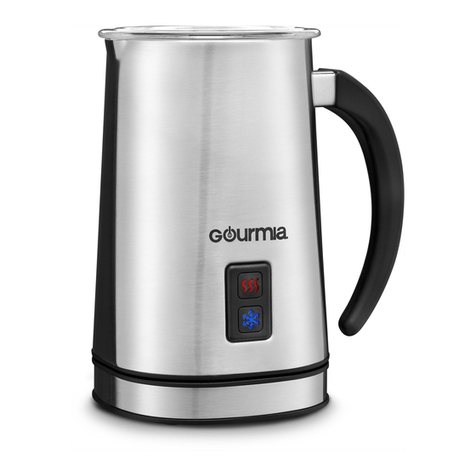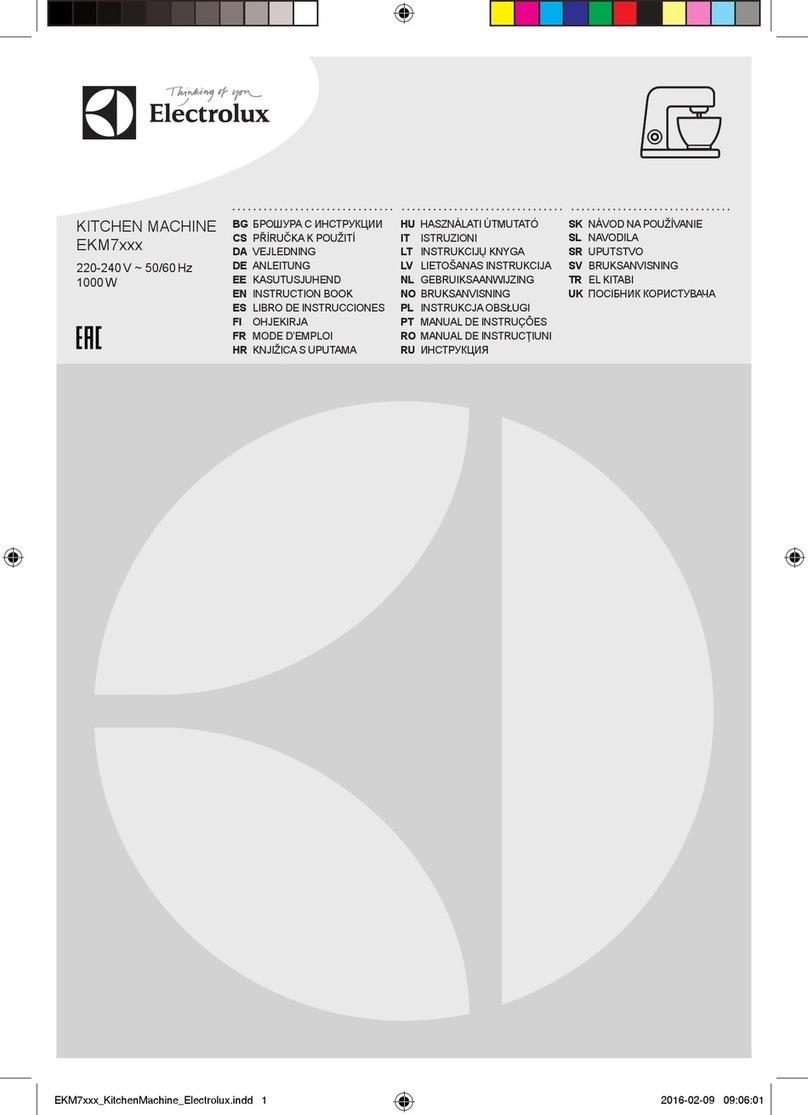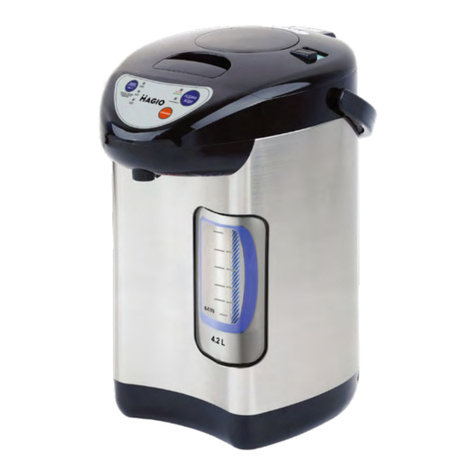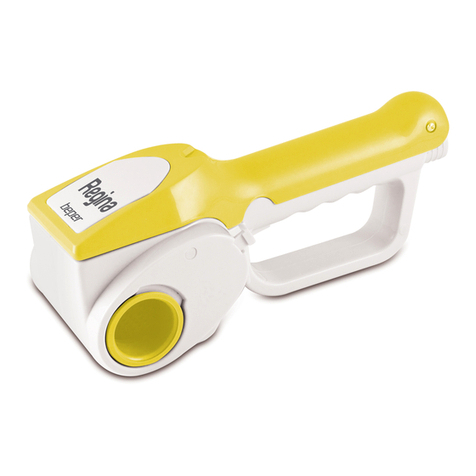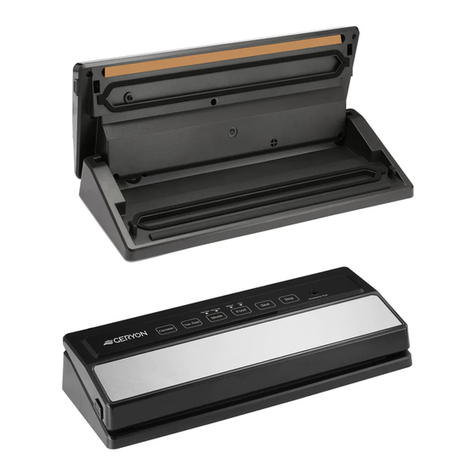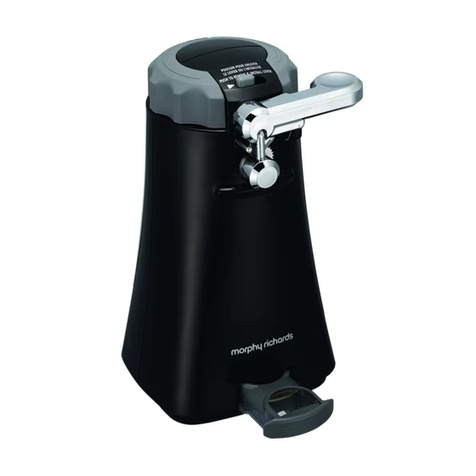ARIETE Cualdissima 1377 User manual

Via San Quirico, 300
50013 Campi Bisenzio (FI)
E-Mail: [email protected]
Internet: www.ariete.net
COD. 4025105800 REV. 0 del 21/12/2009
827070

N
M
F
P
J
C
E
D
S
H
G
A
I
Q
B
I
L
Q
R
N
M
O
O
F
Fig. 6
Fig. 7 Fig. 8 Fig. 9
Fig. 10
Fig. 1
Fig. 3
Fig. 4 Fig. 5
Fig. 2
Fig. 11
Fig. 13
Fig. 12
T
Fig. 14
U
V
T
U
V
Fig. 15

3
Anche se gli apparecchi sono stati realizzati in conformità con le speciche Normative europee vigenti e sono pertanto
protetti in tutte le parti potenzialmente pericolose, leggete con attenzione queste avvertenze e usate l’apparecchio solo per
l’uso cui è stato destinato per evitare infortuni e danni. Tenete a portata di mano questo libretto per future consultazioni.
Qualora vogliate cedere questo apparecchio ad altre persone ricordatevi di includere anche queste istruzioni.
Le informazioni riportate in questo manuale sono marcate dai seguenti simboli che indicano:
Pericolo per i bambini Avvertenza relativa a ustioni
Pericolo dovuto a elettricità Attenzione - danni materiali
Pericolo di danni derivanti da altre cause
Potete usare la vostra Café Chic per preparare caffè e cappuccino; inoltre grazie alla possibilità di erogare acqua calda si
possono preparare anche tè e infusi. Questo apparecchio è stato concepito solo per un uso privato ed è quindi da conside-
rarsi inadeguato l’uso per scopi commerciali o industriali.
Ogni altro utilizzo della macchina non è previsto dal Costruttore che si esime da qualsiasi responsabilità per danni di ogni
natura, generati da un impiego improprio della macchina stessa. L’uso improprio determina inoltre l’annullamento di ogni
forma di garanzia.
Le caratteristiche costruttive dell’apparecchio, oggetto della presente pubblicazione, non consentono di proteggere l’utiliz-
zatore dal getto diretto di vapore o acqua calda.
Pericolo di ustioni - Nell’erogazione di acqua calda e di vapore, non dirigere i getti verso terzi o verso se stessi.
Impugnare il tubo, esclusivamente sulla parte in plastica.
Utilizzare solo contenitori che siano realizzati in materiale “per alimenti”.
• L’apparecchio è destinato solo ad uso domestico, e non deve essere adibito ad uso commerciale o industriale.
• Non si assumono responsabilità per uso errato o per impieghi diversi da quelli previsti dal presente libretto.
• Si consiglia di conservare gli imballi originali, poiché l’assistenza gratuita non è prevista per i guasti causati da imballo non
adeguato del prodotto al momento della spedizione ad un Centro di Assistenza autorizzato.
• L’apparecchio è conforme alla Direttiva 2006/95/CE e alla Direttiva EMC 2004/108/CE.
• Questo apparecchio non deve essere utilizzato da persone (compresi i bambini) con capacità siche, sensoriali o mentali
ridotte; da persone che manchino di esperienza e conoscenza dell’apparecchio, a meno che siano attentamente sor-
vegliate o ben istruite relativamente all’utilizzo dell’apparecchio stesso da parte di una persona responsabile della loro
sicurezza.
• Assicurarsi che i bambini non giochino con l’apparecchio.
• Gli elementi dell’imballaggio non devono essere lasciati alla portata dei bambini in quanto potenziali fonti di pericolo.
• Allorché si decida di smaltire come riuto questo apparecchio, si raccomanda di renderlo inoperante tagliandone il cavo di
alimentazione. Si raccomanda inoltre di rendere innocue quelle parti dell’apparecchio suscettibili di costituire un pericolo,
specialmente per i bambini che potrebbero servirsi dell’apparecchio per i propri giochi.
• Prima di collegare l’apparecchio alla rete di alimentazione controllare che la tensione indicata sulla targhetta posta al di
sotto della macchina corrisponda a quella della rete locale.
• L’uso di prolunghe elettriche non autorizzate dal fabbricante dell’apparecchio può provocare danni e incidenti.
• Se il cavo di alimentazione è danneggiato, esso deve essere sostituito dal costruttore o dal suo servizio Assistenza Tec-
nica o comunque da una persona con qualica similare, in modo da prevenire ogni rischio.
• Prima di procedere all’operazione di riempimento del serbatoio dell’acqua, scollegare l’apparecchio dalla presa di corrente.

4
• Non mettere mai le parti sotto tensione a contatto con l’acqua: può generarsi un cortocircuito!
• Togliere la spina dalla presa prima di ogni intervento di pulizia o di manutenzione.
• NON IMMERGERE L’APPARECCHIO IN ACQUA O ALTRI LIQUIDI.
• In caso di guasti, difetti o sospetto difetto dopo una caduta, staccare subito la spina dalla presa di corrente. Non mettere
mai in funzione l’apparecchio difettoso. LE RIPARAZIONI POSSONO ESSERE EFFETTUATE ESCLUSIVAMENTE DAI
CENTRI DI ASSISTENZA AUTORIZZATI. Si declina ogni responsabilità per eventuali danni provocati da interventi di
riparazione eseguiti in modo non corretto.
• Non sollevare l’apparecchio afferrandolo per il serbatoio dell’acqua, ma afferrarlo per il corpo.
• Scegliere un ambiente sufcientemente illuminato, pulito e con la presa di corrente facilmente accessibile.
• Evitare di immettere nel serbatoio una quantità eccessiva di acqua.
• L’apparecchio non deve essere utilizzato se è stato fatto cadere, se vi sono segni di danni visibili o se ha perdite di acqua.
Tutte le riparazioni, compresa la sostituzione del cavo di alimentazione, devono essere eseguite solamente dal Centro
Assistenza Autorizzato o da persona con qualica similare, al ne di prevenire ogni rischio.
• Non usare l’apparecchio se il cavo di alimentazione si presenta danneggiato, con parti recanti bruciature, ecc...; la ripara-
zione e la sostituzione del cavo di alimentazione devono essere effettuate da un centro di assistenza autorizzato Ariete;
pena il decadimento della garanzia.
• Non dirigere mai il getto di vapore o acqua calda verso parti del corpo; manipolare con precauzione il tubo vapore/acqua
calda: pericolo ustioni!
• Le parti metalliche esterne dell’apparecchio non devono essere toccate con l’apparecchio in funzione, in quanto potreb-
bero causare delle scottature.
• La mancata fuoriuscita di acqua dal portaltro potrebbe essere dovuta ad un intasamento del ltro Thermocream®.
Interrompere l’erogazione ed attendere una decina di secondi. Successivamente rimuovere e disinserire lentamente
il portaltro perché l’eventuale pressione residua potrebbe provocare spruzzi o schizzi. Procedere quindi con la pulizia
come indicato nell’apposito paragrafo.
• Collocare la macchina su un piano stabile dove non possa essere rovesciata.
• Non usare la macchina senza acqua, poiché in tale caso la pompa si brucerebbe.
• Non riempire mai il serbatoio dell’acqua con acqua calda o bollente.
• Non posizionare la macchina su superci molto calde o nelle vicinanze di amme libere per evitare che la carrozzeria
possa essere danneggiata.
• Il cavo non deve toccare le parti calde della macchina.
• Non utilizzare acqua gassata (addizionata di anidride carbonica).
•
Utilizzare solo con caffè in polvere o con cialde che riportano il marchio standard E.S.E.
• Non introdurre mai nel portaltro sostanze diverse dal caffè.
Si potrebbero causare gravi danni all’apparecchio.
• Non lasciare la macchina a temperatura ambiente inferiore a 0°C, in quanto il residuo d’acqua nella caldaia potrebbe
ghiacciare e provocare dei danni.
• Non usare l’apparecchio all’aperto.
• Non lasciare l’apparecchio esposto ad agenti atmosferici (pioggia, sole, ecc...).
• Dopo aver staccato la spina di alimentazione e dopo che le parti calde si saranno freddate, l’apparecchio dovrà essere
pulito esclusivamente con un panno non abrasivo appena inumidito aggiungendo poche gocce di detergenti neutri non
aggressivi (non usare mai solventi che danneggiano la plastica).
•

5
A - Corpo Prodotto L - Spia temperatura caldaia
B - Serbatoio acqua estraibile M - Disco Thermocream®
C - Dispositivo Maxi Cappuccino e N - Filtro Thermocream®
stilo erogatore acqua/vapore O - Disco forato in silicone
D - Vaschetta raccogligocce P - Misurino/pressino per caffè
E - Griglia appoggiatazze estraibile Q - Interruttore vapore
F - Portaltro per caffè in polvere R - Spia funzione vapore
G - Pulsante di accensione S - Manopola di erogazione vapore
H - Spia accensione T - Portaltro per cialda
I - Interruttore erogazione caffè U - Filtro per cialde
J - Cavo alimentazione + spina V - Gocciolatore
Nella targhetta posta sotto la base di appoggio della macchina sono riportati i seguenti dati d’identicazione della macchina:
• costruttore e marcatura CE
• modello (Mod.)
• numero di matricola (SN)
• tensione elettrica di alimentazione (V) e frequenza (Hz)
• potenza elettrica assorbita (W)
• numero verde assistenza
Nelle eventuali richieste ai centri assistenza autorizzati, indicare modello e numero di matricola.
Controllare che la tensione della rete domestica sia uguale a quella indicata sulla targhetta dati tecnici dell’apparecchio.
Posizionare poi la macchina su una supercie piana.
Lavare il serbatoio al primo utilizzo e riempirlo con acqua naturale fresca, avendo poi cura di inserirlo bene nella sua sede.
Inserire la spina nella presa di corrente elettrica, che deve essere dotata di messa a terra.
Dopo aver riempito il serbatoio con acqua naturale fresca, mettere in funzione la macchina premendo il tasto (G). Si ac-
cenderanno la spia (H), la quale indica che la macchina è accesa, e la spia (L) ad indicare che la caldaia interna inizia a
riscaldarsi. Posizionare un recipiente sopra la griglia appoggiatazze (E) e premere il pulsante di erogazione caffè (I), no a
quando si vedrà fuoriuscire acqua dalla sede del portaltro (Fig. 4).
Ruotare nel senso inverso la manopola (S) per interrompere l’uscita di acqua dal cappuccinatore e disinserire il pulsante (I). Dopo una
breve pausa si noterà che la spia (L) si è spenta, ad indicare che la caldaia è giunta alla giusta temperatura per preparare il caffè.
Inserire nel portaltro il disco Thermocream® (M), il disco forato in silicone (O) e il ltro Thermocream® (N) nell’ordine indi-
cato (Fig. 3). Dosare il caffè nel ltro e pressare leggermente con l’apposito pressino: per due caffè riempire completamente
due misurini, mentre per un caffè riempirne uno solo. Innestare il portaltro nell’apposita sede.
Serrarlo bene ruotandolo da sinistra verso destra, assicurandosi di averlo ben agganciato alla angia (Fig. 5).
Se viene inserita una quantità eccessiva di polvere di caffè all’interno del ltro, può risultare difcoltoso stringere a
fondo nella sua sede il portaltro e/o durante l’erogazione del caffè si possono avere perdite dal portaltro.
È consigliabile lasciar riscaldare il portaltro tenendolo inserito nella sua sede per qualche minuto prima di fare un caffè in
modo da avere anche il primo caffè ben caldo. Questo non sarà necessario per i successivi caffè.
Premere il pulsante (I): inizierà la fuoriuscita del caffè dai beccucci del portaltro. Per interromperla ripremere il pulsante (I).
La dose massima per un caffè è di 50 ml.

6
Come nelle macchine da caffè professionali, non togliere il portaltro quando l’interruttore di erogazione (I) è inse-
rito; pericolo di ustioni!
Al termine dell’erogazione del caffè attendere almeno una decina di secondi prima di disinserire il portaltro; per
rimuovere il portaltro ruotarlo lentamente da destra verso sinistra onde evitare spruzzi o schizzi di acqua o caffè.
Quando la macchina è ferma in attesa di comandi, la spia (L) si spegnerà e accenderà periodicamente, mostrando l’inter-
vento del termostato della caldaia, che serve a mantenere ottimale la temperatura dell’acqua.
È opportuno, sia per il primo caffè che per i successivi, avviare l’erogazione del caffè solo quando la spia (L) è spenta.
Per fare il caffè con cialda occorre utilizzare l’apposito portaltro per cialda (T) in dotazione nel seguente modo:
1 Inserire nel portaltro (T) il gocciolatore (V) e il ltro per cialde (U) (Fig. 12).
2 Posizionare la cialda nel portaltro (Fig. 13).
3 Spingere la cialda con le dita verso l’interno (Fig. 14).
4 La cialda deve essere ben centrata e collocata all’interno del portaltro.
5 Adesso è possibile inserire il portaltro nella sua sede. Serrare bene il portaltro assicurandosi di averlo ben agganciato
alla angia (Fig. 5).
6 Dopo aver preparato il caffè, nel togliere il portaltro, la cialda potrebbe rimanere incastrata nella parte superiore della
macchina. Per toglierla, inclinare il portaltro (Fig. 15), lasciando che la cialda ricada sullo stesso.
Per avere un caffè sempre ottimo occorre acquistare la cialda che presenta il marchio di compatibilità E.S.E.
Non è necessaria alcuna operazione particolare quando si esaurisce l’acqua nel serbatoio, perché la macchina possiede
una speciale valvola di auto-innesco. Basterà, dopo aver disinserito la spina dalla presa della corrente, estrarre il serbatoio
e riempirlo nuovamente con acqua naturale fresca.
Per preparare un cappuccino, una cioccolata calda, o riscaldare qualsiasi altra bevanda, premere il pulsante (Q); la spia
(R) si accenderà ad indicare che è stata inserita la funzione vapore. La spia (L) si accende ad indicare che l’acqua nella
caldaia inizia a scaldarsi. Quando la spia (L) si spegne, la macchina è giunta alla giusta temperatura per erogare vapore.
Ruotare la manopola di erogazione vapore (S), avendo l’accortezza di posizionare un bicchiere sotto il dispositivo Maxi
Cappuccino (C) Fig. 7: dapprima uscirà un po’ d’acqua e subito dopo un forte getto di vapore.
Richiudere la manopola vapore (S) e porre sotto il dispositivo Maxi Cappuccino il bricco del latte da montare. Immergere a
fondo lo stilo nel bricco del latte (Fig. 8) e ruotare nuovamente la manopola di erogazione (S) no ad ottenere il risultato vo-
luto. Durante queste operazioni si potrà notare che la spia (L) si spegne e riaccende periodicamente, indicando gli interventi
del termostato che mantiene la giusta temperatura della caldaia per l’erogazione del vapore.
Terminata la preparazione del cappuccino disinserire la funzione vapore premendo il pulsante (Q).
Per preparare un caffè subito dopo aver fatto il cappuccino sarà necessario riportare la caldaia alla temperatura di prepa-
razione caffè compiendo queste operazioni: disinserire la funzione vapore premendo il pulsante (Q). La spia (R) cesserà di
lampeggiare e rimarrà accesa solo la spia di accensione (H).
Posizionare un recipiente sotto lo stilo (C), premere il pulsante (I) e contemporaneamente ruotare la manopola (S) come per
l’erogazione del vapore. Far uscire dal dispositivo Maxi Cappuccino acqua no a quando la spia luminosa (L) si accenderà
di nuovo; richiudere la manopola (S) e ripremere il pulsante (I).
Attendere che la spia (L) si spenga per fare un nuovo caffè.

7
Quando la macchina si trova in posizione di pronto caffè cioè con la spia (L) spenta, posizionare una tazza sotto lo stilo
erogatore (C) e premere l’interruttore di erogazione del caffè (I). Ruotare subito dopo la manopola erogazione vapore (S);
così facendo dal beccuccio uscirà acqua calda. La dose massima per due tazze è di 200 ml.
Il caffè macinato nel portaltro dovrà essere pressato leggermente. Un caffè più forte o meno forte dipende dal grado di
macinatura del caffè, dalla quantità di esso immessa nel portaltro, e dalla pressatura. Pochi secondi sono il tempo suf-
ciente perché il caffè scenda nelle tazzine. Se il tempo di erogazione è superiore signica che la macinatura è troppo ne o
che la polvere immessa nel portaltro è stata pressata eccessivamente.
Tutte le operazioni di pulizia sotto indicate devono essere effettuate a macchina spenta e con la spina elettrica
scollegata dalla presa di corrente.
Una manutenzione ed una pulizia regolari preservano e mantengono efciente la macchina per un periodo maggio-
re. Non lavare mai i componenti della macchina in lavastoviglie. Non utilizzare getti di acqua diretta.
Ogni intervento va eseguito a macchina fredda.
Vericare che i forellini sottostanti non si otturino e nel caso ripulirli con uno spazzolino (Fig. 9). Far erogare acqua bollente
dal portaltro con il ltro inserito senza la polvere dopo aver posizionato un bicchiere sotto l’erogatore, per sciogliere o
rimuovere eventuali residui di caffè o impurità.
Rimuovere e disinserire lentamente il portaltro perché l’eventuale pressione residua potrebbe provocare spruzzi
o schizzi.
Si consiglia di pulire accuratamente il ltro (R) ogni circa 3 mesi, utilizzando le pastiglie detergenti COFFEE CLEAN di
Ariete reperibili presso i punti vendita ed i Centri Assistenza Autorizzati seguendo le istruzioni contenute nella confezione
oppure, in alternativa, utilizzando una pastiglia di detersivo semplice (senza aggiunta di brillantante o altri additivi chimici)
per lavastoviglie nel seguente modo:
• Inserire una pastiglia di detersivo da lavastoviglie nel ltro (senza caffè) quando la macchina è ben calda (dopo almeno 5
minuti di riscaldamento).
• Agganciare il portaltro alla macchina e mettere un recipiente sotto il portaltro.
• Premere il tasto caffè per avviare l’erogazione dell’acqua e erogare acqua per 15-20 secondi.
• Interrompere l’erogazione e lasciare agire la pastiglia per almeno 15 minuti mantenendo il portaltro inserito sulla macchi-
na.
• Ripetere l’operazione di erogazione dell’acqua facendo funzionare la pompa per circa 15-20 secondi e poi lasciando
riposare per altri 15-20 secondi no ad esaurire due serbatoi di acqua.
• Rimuovere il portaltro dalla macchina, estrarre il ltro e sciacquarlo bene sotto l’acqua corrente del rubinetto.
• Spegnere la macchina, scollegare il cavo di alimentazione dalla presa di corrente e pulire con una spugnetta la sede di
aggancio del portaltro per rimuovere eventuali residui di detersivo dalla doccia.
• Riaccendere la macchina, agganciare nuovamente il portaltro ed erogare ancora almeno 2 tazze di acqua per comple-
tare il risciacquo.
Se la macchina da caffè viene utilizzata quotidianamente si consiglia di effettuare l’operazione di pulizia almeno ogni tre
mesi.
Con il portaltro agganciato, senza la cialda inserita, avviare l’erogazione premendo il pulsante (I) dopo aver posizionato
un bicchiere sotto il portaltro. In questo modo eventuali residui di caffè o impurità presenti nel portaltro si scioglieranno
e verranno rimossi.
Lavare il disco in silicone (O) sotto l’acqua corrente piegandolo leggermente ai lati in modo da liberare il foro centrale da
eventuali residui di polvere di caffè che potrebbero ostruirlo (Fig. 10).

8
Con l’uso si può vericare, nella sede di aggancio del portaltro, una sedimentazione di fondi di caffè, che possono essere
rimossi con uno stuzzicadenti, con una spugnetta (Fig. 11), oppure lasciando scorrere acqua senza portaltro inserito (Fig. 4).
Non lavare il portaltro in lavastoviglie
Eseguire l’operazione quando il tubo cromato è freddo per evitare scottature.
Svitare il dispositivo (C) dal tubetto, e lavarlo con acqua corrente. Il tubetto può essere pulito con un panno non abrasivo.
Riavvitare il cappuccinatore no alla ne della corsa. Se necessario ripulire con uno spillo il forellino di uscita del vapore.
Dopo ogni utilizzo erogare il vapore per alcuni secondi per liberare il foro da eventuali residui.
Si consiglia di pulire periodicamente l’interno del serbatoio (B) con una spugna o un panno umido.
Slare la vasca raccogligocce (D) dalla macchina, svuotarla e lavarla sotto l’acqua corrente. Estrarre la griglia (E) e lavarla
sotto l’acqua corrente.
Pulire le parti sse della macchina usando un panno umido non abrasivo per non danneggiare la carrozzeria.
In base alla nostra esperienza e grazie alle tecniche di costruzione della macchina da caffè, non si formano depositi calcarei
nell’apparecchio. Se nonostante ciò, dopo qualche tempo, la funzione dell’apparecchio dovesse essere compromessa, in
seguito all’uso frequente di acqua dura e molto calcarea, si può procedere alla decalcicazione della macchina per elimi-
nare il malfunzionamento. Utilizzate per questo scopo esclusivamente il prodotto decalcicante dell’Ariete a base di acido
citrico (NOCAL). Questo prodotto si può reperire facilmente nei centri di assistenza tecnica Ariete. Ariete non si assume
alcuna responsabilità per danni ai componenti interni della macchina da caffè arrecati dall’uso di prodotti non conformi a
causa della presenza di additivi chimici. In caso di necessità di una decalcicazione, osservate le indicazioni sul foglio di
istruzioni del prodotto decalcicante.
In caso di messa fuori servizio della macchina occorre sconnetterla elettricamente, svuotare il serbatoio dell’acqua e la
vaschetta raccogligocce e ripulirla (vedi paragrafo “Pulizia dell’apparecchio”).
In caso di rottamazione si dovrà provvedere alla separazione dei vari materiali utilizzati nella costruzione della macchina
e provvedere al loro smaltimento in base alla loro composizione e alle disposizioni di legge vigenti nel Paese di utilizzo.

9
In caso di anomalie di funzionamento, spegnere immediatamente la macchina, e slare la spina dalla presa elettri-
ca. Contattare il centro di assistenza più vicino.
Probabilmente è entrata aria nel
circuito e ciò ha disinnescato la
pompa.
Vericare che il serbatoio sia ben inserito ed il livello non sia
sceso sotto il minimo indicato dall’apposito riferimento riportato
sullo stesso. Ripetere le operazioni descritte nel paragrafo “Fasi
preliminari per l’uso”.
Foro di uscita vapore dello stilo
erogatore ostruito.
Stasare con uno spillo eventuali incrostazioni formatosi nel foro
dello stilo erogatore.
C’è poca acqua e la pompa non
aspira.
Controllare che il livello dell’acqua nel serbatoio sia regolare e in
caso riempire con acqua naturale fresca.
Foro di uscita vapore dello stilo
erogatore ostruito.
Stasare con uno spillo eventuali incrostazioni formatosi nel foro
dello stilo erogatore.
Probabilmente nel portaltro
è stata immessa una quantità
eccessiva di caffè macinato che
ha impedito di stringere a fondo
il portaltro nella sua sede.
Rimuovere e disinserire lentamente il portaltro perché
l’eventuale pressione residua potrebbe provocare spruzzi o
schizzi. Ripulire la sede di aggancio con una spugnetta (Fig. 11).
Ripetere l’operazione, immettendo nel ltro la giusta quantità di
caffè.
Sulla guarnizione della sede di
aggancio del portaltro sono
rimasti residui di caffè macinato.
Provvedere a ripulire la guarnizione con uno stuzzicadenti o con
una spugnetta (Fig. 11).
Il foro del disco in silicone è
otturato.
Lavare il disco in silicone (O) sotto l’acqua corrente piegandolo
leggermente ai lati in modo da liberare il foro centrale da even-
tuali residui di polvere di caffè che potrebbero ostruirlo (Fig. 10).
Il ltro contenente macinato ha i
forellini di uscita ostruiti.
Rimuovere e disinserire lentamente il portaltro perché l’even-
tuale pressione residua potrebbe provocare spruzzi o schizzi.
Ripulire con uno spazzolino o uno spillo i forellini otturati del
ltro. Detergere il ltro utilizzando le pastiglie COFFEE CLEAN di
Ariete seguendo le istruzioni riportate nella confezione.
Cialda difettosa Sostituire la cialda nel portaltro (T)
Si sta cercando di erogare il
caffè con la funzione vapore
inserita. Controllare che il tasto
della funzione vapore non sia
stato inserito
Interrompere l’erogazione del caffè. Premere il tasto (Q) per
disinserire la funzione vapore. Attendere che la spia (L) si sia
accesa e spenta di nuovo per preparare il caffè.

10
La sede di aggancio del
portaltro ha i fori ostruiti.
Azionare la macchina senza portaltro facendo deuire l’acqua.
Se l’acqua continua a non uscire uniformemente da tutti i fori,
eseguire la pulizia anticalcare utilizzando il prodotto Ariete
NOCAL reperibile nei centri di assistenza Ariete seguendo le
istruzioni riportate nella confezione.
Il ltro contenente macinato ha i
forellini di uscita ostruiti.
Rimuovere e disinserire lentamente il portaltro perché l’even-
tuale pressione residua potrebbe provocare spruzzi o schizzi.
Ripulire con uno spazzolino o uno spillo i forellini otturati del
ltro. Detergere il ltro utilizzando le pastiglie COFFEE CLEAN di
Ariete seguendo le istruzioni riportate nella confezione.
Miscela di caffè macinata troppo
ne.
Provare ad utilizzare miscele di caffè a grana più grossa.
Miscela di caffè troppo pressata. Pressare il caffè nel ltro con minor pressione.
Il serbatoio non è ben inserito. Inserire bene il serbatoio spingendolo a fondo.
Il foro del disco in silicone è
otturato.
Lavare il disco in silicone (O) sotto l’acqua corrente piegandolo
leggermente ai lati in modo da liberare il foro centrale da even-
tuali residui di polvere di caffè che potrebbero ostruirlo (Fig. 10).
C’è poca acqua e la pompa non
aspira.
Controllare che il livello dell’acqua nel serbatoio sia regolare e in
caso riempire con acqua naturale fresca.
Cialda difettosa Sostituire la cialda nel portaltro (T)
Rottura della cialda Togliere il portaltro per cialde (T), pulire la sede con una spugnet-
ta e reinserire una nuova cialda.
La miscela è stata macinata
troppo grossa.
Per ottenere un caffè più concentrato e più caldo, si deve usare
una miscela più nemente macinata.
In ogni caso questo problema si elimina grazie al Sistema
Thermocream®, che assicura sempre un caffè bollente ed una
ricca crema, anche con caffè macinato grosso.

11
Even if the appliances are made in conformity with the European regulatory specications in force and therefore all poten-
tially hazardous parts are protected. Carefully read these warnings and use the appliance only for the use it is designed for
in order to prevent accidents and damage. Keep this manual close by for future consultation. If you should decide to give
this appliance to other people, remember to also include these instructions.
The information provided in this manual is marked with the following symbols indicating:
Danger for children Warning of burns
Danger due to electricity Warning – material damage
Danger of damage originating from other causes
You may use your Café Chic to prepare coffee and cappuccino, and thanks to the possibility of dispensing hot water, you can
also prepare tea and tisanes. This appliance is designed only for private use, and is therefore to be considered unsuitable
for commercial or industrial purposes.
No other use of the machine is contemplated by the manufacturer, which is exempt from any liability for all types of damages
caused by improper use of the machine. Improper use also results in any form of warranty being forfeited.
The construction characteristics of the appliance this publication refers to do not allow the user to be protected from a direct
jet of steam or hot water.
Danger of burns – When dispensing hot water and steam, do not direct the jets towards others or yourself. Hold
only the plastic part of the tube.
Use only containers made of material “for foods”.
• This appliance is designed only for private use, and is therefore to be considered unsuitable for commercial or industrial
purposes.
• We decline any responsibility resulting from misuse or any use other than those covered in this booklet.
• We suggest you keep the original box, as our free-of-charge service does not cover transportation damage due to inad-
equate packaging of the product when sent to an Authorised Service Centre.
• This product complies with the 2006/95/EC Directive and EMC Directive 2004/108/EC.
• This appliance is not suitable for use by people (children included) with physical, sensorial or mental disabilities. Users
lacking experience and knowledge of the appliance, or those who have not been given the user’s instructions, must be
supervised by a person responsible for their safety.
• Children must be supervised at all times to ensure they do not play with the appliance
.
• Do not leave the packing components near children because they are potentially dangerous.
• In the event that this appliance is to be disposed of, it is recommended that the power chord be cut. It is also recom-
mended that all potentially dangerous components are rendered harmless to prevent children from hurting themselves
when playing with the apparatus.
• Before connecting the appliance to the power supply, make sure that the voltage indicated on the plate on the bottom of
the machine corresponds to the local mains voltage.
• The use of extension leads, which have not been authorised by the appliance manufacturer, may cause damage and accidents.
• If the electric cable is damaged it must be replaced by the manufacturer or its Technical Assistance Service, or in any case
by a person with similar qualications, in order to avoid any risk.
• Before lling the tank with water, remember to always disconnect the appliance at the socket.
• Never let the live parts come into contact with water: this may cause a short circuit!

12
• Unplug before any cleaning or maintenance operations.
• DO NOT IMMERSE THE APPLIANCE IN WATER OR OTHER LIQUIDS.
• Unplug the appliance from the electricity supply immediately in the case of faults, defects or suspected defects after drop-
ping. Never operate the appliance if defective. REPAIRS MAY ONLY BE CARRIED OUT BY AUTHORIZED ASSISTANCE
SERVICE CENTRES. The manufacturer disclaims all responsibility for any damage caused by incorrect repair work.
• Do not lift the appliance by grasping its water tank, but only by grasping its body.
• Choose a sufciently well lit and clean environment, with an easily accessible electric socket.
• Avoid putting excessive quantities of water into the tank.
• The appliance is not to be used if it has been dropped, if there are visible sign of damage or if it is leaking. To prevent any
accident, all repairs, including the replacement of the power cord, must be carried out by an Authorised Service Centre or,
in any case, by qualied personnel.
• Do not use the appliance if the power cord appears to be damaged, with parts showing burns, etc.; an authorised Ariete
service centre must repair and replace the power cable, under penalty of the warranty being forfeited.
• Never direct the steam or hot water jet towards parts of the body; handle the steam/hot water spout with care: risk of scalding!
• The appliance’s external metallic parts must not be touched when the machine is functioning as it could cause burns.
• If water does not come out of the lter holder, it may be because the Thermocream® lter is clogged. Stop the brewing
and wait ten seconds. Remove and disconnect the lter holder because any remaining pressure could cause splashes or
squirts. Then clean as explained in the relevant paragraph.
• Place the machine on a stable surface where it cannot be knocked over.
• Never use the machine without water because the pump will burn out.
• Never ll the water tank with hot or boiling water.
• Do not place the machine on very hot surfaces or near open ames in order to prevent damage to the body.
• The cable must not touch any hot parts of the machine.
• Do not use sparkling water (with added carbon dioxide).
• Use only ground coffee or pods bearing the E.S.E. standard mark.
• Never put substances other than coffee into the lter holder. They could cause serious damage to the appliance.
• Do not leave the machine at a room temperature below 0°C because the water remaining in the boiler could freeze and
cause damage.
• Never use the appliance outdoors.
• Do not expose the appliance to atmospheric agents (rain, sun …).
• Before cleaning the appliance always unplug it and allow it cool down. Clean only with a non-abrasive cloth that has been
slightly dampened with water, adding a few drops of mild, non-aggressive detergent (never use solvents that damage
plastic).
•
A - Product Body L - Heating unit warning light
B - Removable water tank M - Thermocream® disc
C - MAXI CAPPUCCINO attachment and N - Thermocream® lter
wand for water and steam supply O - Perforated silicon disc
D - Drip tray P - Coffee measure/presser
E - Removable cup-resting grill Q - Steam switch
F - Filter holder for ground coffee R - Steam function indicator lamp
G - On/off button S - Steam dispensing knob
H - On warning light T - Pod lter holder
I - Coffee dispensing button U - Pod lter
J - Cord + plug V - Drain pan
The following machine identication data are shown on the plate found underneath the machine’s standing base:
• manufacturer and CE mark
• model (Mod.)
• serial number (SN)

13
• electrical supply voltage (V) and frequency (Hz)
• absorbed electric power (W)
• assistance toll-free number
Always give the model and serial number to the Authorised Service Centres when requesting assistance.
Check that the voltage of the domestic network is the same as that indicated on the technical information plate of the appli-
ance. Place the appliance on a at surface, ensuring the suction cups stick rmly to the surface.
Before using the appliance for the rst time wash the tank. Fill it up with fresh cool water and insert it in its housing. Insert
the plug into the socket, which must be earthed.
After having lled the tank with cool tap water, start the machine by pressing the button (G). The indicator lamp (H) will turn
on, indicating that the machine is on, as well as indicator lamp (L), indicating that the internal boiler is starting to heat up.
Place a container on the cup-holding plate (E). Press the coffee dispensing switch (I) until you see water come out of the
lter holder seat (Fig. 4).
Turn the knob in the opposite direction (S) to stop the water from coming out of the cappuccino maker and release the but-
ton (I). After a short while you will notice that the indicator lamp (L) turns off to indicate that the boiler has reached the right
temperature for preparing coffee.
Put the Thermocream® Disc (M), the perforated silicone disc (O) and the Thermocream® Filter (N) into the lter holder in
the order indicated (Fig. 3). Measure out the coffee in the lter and lightly press with the specially provided presser. Insert
the lter holder into its seat.
Tighten well by turning it from left to right while making sure you have hooked it properly onto the ange (Fig. 5).
If too much ground coffee is put inside the lter, turning the lter holder may prove difcult and/or you may get leaks
from the lter holder when the coffee is being dispensed.
It is advisable to let the lter holder heat up a few minutes in its seat before making a cup of coffee so that the rst cup is
piping hot, too. This will not be necessary for the cups of coffee that follow.
Press the button (I). The coffee will start coming out of the spouts of the lter holder. Press the button (I) again to stop it.
The minimum serving of coffee is 50 ml.
Like in professional coffee machines, do not remove the lter holder when the dispensing switch (I) is on; danger
of burns!
Wait about ten seconds after the coffee has been dispensed before removing the lter holder. To remove it, turn it
slowly from right to left so as to prevent splashes or spurts of water or coffee.
When the machine is stopped waiting for commands, the lamp (L) will turn on and off periodically. This shows that the boiler
thermostat is tripping, which serves to keep the water temperature optimum.
It is a good idea to start dispensing the coffee only when the indicator lamp (L) is off.
To make coffee with pods you must use the specic pod lter (T) that came with the coffee maker as described below:
1 Put the drip tray (V) and pod lter (U) inside the lter holder (T) (Fig. 12).
2 Place the pod in the lter ring (Fig. 13).

14
3 Push the pod towards the bottom of the lter with your ngers (Fig. 14).
4 The pod must be well centred and placed inside the lter.
5 Now it is possible to put the lter holder in its seat. Tighten the lter holder while making sure you have hooked it properly
onto the ange (Fig. 5).
6 The pod could remain stuck in the upper part of the machine after making the coffee and when removing lter holder. To
remove it, tilt the lter holder (Fig. 15) so the pod can fall onto it.
In order to always get an excellent cup of coffee, buy the pod that bears the E.S.E. compatibility mark.
No special operation is necessary when the water in the tank runs out as the machine is equipped with a special self-priming
device. Just unplug the machine, pull out the tank and ll it with fresh cool water again.
To prepare a cappuccino, hot chocolate or heat any other beverage, press the button (Q). The lamp (R) will turn on, showing
that the steam function has been switched on. The lamp (L) turns on to show that the water in the boiler has started to heat
up. The machine has reached the right temperature for dispensing steam when the lamp (L) turns off.
Turn the steam dispensing knob (S), having the foresight to position a cup underneath the Maxi Cappuccino (C) device (Fig.
7): at rst a little water will come out, immediately followed by a strong jet of steam.
Close the steam dispensing knob again (S) and put the pot of milk to be whipped underneath the Maxi Cappuccino device.
Plunge the wand all the way into the pot of milk (Fig. 8) and turn the steam dispensing knob again (S) again until you get the
result you want. During these operations you may notice that the warning light (L) goes on and off from time to time, indicat-
ing that the boiler thermostat is keeping the water required for the steam supply at the right temperature.
When the cappuccino is ready, turn off the steam function by pressing the button (Q).
To prepare a cup of coffee right after making cappuccino, it is necessary to bring the boiler back to the coffee preparation
temperature by performing these operations: switch off the steam function by pressing the button (Q). The lamp (R) will stop
blinking and only the on indicator lamp (H) will stay on.
Place a container underneath the wand (C), press the button (I) and at the same time turn the steam dispensing knob (S).
Have water come out of the Maxi Cappuccino device until the indicator lamp (L) turns on again; close the knob again (S)
and press the button again (I).
Wait for the lamp (L) to turn off before making another cup of coffee.
When the machine is in the coffee-ready position, i.e. with the lamp (L) off, put a cup underneath the dispensing wand (C)
and press the coffee dispensing switch (I). Immediatly turn the steam dispensing knob (S); in this way hot water will come
out of the spout. The maximum quantity for two cups is 200 ml.
The ground coffee in the lter holder has to be pressed lightly. Whether the coffee is stronger or weaker depends on the
degree the coffee is ground, the quantity put into the lter holder and the pressing.
Just a few seconds are needed for the coffee to ow down into the cups. If the dispensing time is longer, this means that the
coffee is ground too ne or that the coffee put into the lter holder has been pressed too much.
All cleaning operations described below must be performed with the machine off and with the electric plug discon-
nected from the socket-outlet.
Regular maintenance and cleaning preserve and keep the machine efcient for a longer amount of time. Never
wash machine components in the dishwasher. Do not use direct jets of water.

15
All operations must be performed when the machine is cold.
Check that the holes are not clogged and if so, clean them with a small brush (Fig. 9). Dispense boiling water from the lter
holder with the lter inside, without coffee grounds, after placing a glass underneath the dispenser in order to dissolve or
remove any coffee residue or impurities.
Slowly remove and disconnect the lter holder because any remaining pressure could cause splashes or squirts.
It is advisable to thoroughly clean the lter (R) about every 3 months using Ariete COFFEE CLEAN detergent tabs, which
can be found at retail stores and the Authorised Service Centres, following the instructions inside the package. As an al-
ternative, you can use a simple dishwasher detergent tab (without added rinse aid or other chemical additives) as follows:
• Put a dishwasher detergent tab into the lter (without coffee) when the machine is hot (after heating for at least ve minutes).
• Couple the lter holder to the machine and put a container underneath the lter holder.
• Press the coffee button to start dispensing water, and dispense the water for 15-20 seconds.
• Stop the water supply and let the tab act for at least 15 minutes while keeping the lter holder coupled on the machine.
• Repeat the water dispensing operation by operating the pump for about 15-20 seconds, and then letting it rest for another
15-20 seconds, until two tanks of water are used up.
• Remove the lter holder from the machine, remove the lter and rinse it well under running tap water.
• Turn off the machine, disconnect the power cable from the socket-outlet and clean the coupling seat of the lter holder
with a sponge in order to remove any detergent residue from the shower disc.
• Turn the machine back on, couple the lter holder once again and dispense at least 2 cups of water again to complete the
rinsing.
If the coffee machine is used daily, it is advisable to carry out the cleaning operation at least every three months.
Start dispensing with the lter holder connected and without the pod inside by pressing the button (I) after having placed a
glass underneath the lter holder. In this way any coffee residue or impurities present in the lter holder will dissolve and
be removed.
Wash the silicone disc (O) under running water, bending it slightly on the sides in order to free the centre hole of any residue
of coffee grounds that could clog it (Fig. 10).
With time, coffee residue may accumulate on the lter holder seat. It can be removed with a toothpick, a sponge (Fig. 11),
or by letting water run through without tting the lter holder (Fig. 4).
Perform this operation when the chrome-plated pipe is cold so as to prevent burns.
Unscrew the device (C) from the small pipe and wash it with running water. The small pipe can be cleaned with a non-
abrasive cloth. Screw the cappuccino maker back on as far as it will go. If necessary, clean the small steam outlet hole
again with a pin. After use, always let the steam nozzle run for a few seconds so to free the outlet from any possible residue.
Periodically clean the inside of the tank (B) with a sponge or damp cloth.
Remove the drip tray (D) from the machine, empty it and wash it under running water. Remove the grill (E) and wash it
under running water.
Clean the xed parts of the machine using only a damp, non-abrasive cloth so as to not damage the body.

16
Good maintenance and regular cleaning preserve and keep the machine efcient for a longer amount of time, considerably
limiting the risks of lime deposits forming inside the appliance. However, should your coffee machine fail to work properly
as a result of the frequent use of hard, high calcium content water, you may perform a decalcication procedure to restore
its operational efciency. For this purpose you must use only Ariete’s, citric acid-based decalcifying products (NOCAL). This
product is easily found at the Ariete technical service centres. Ariete does not assume any responsibility whatsoever for
damage to components inside the coffee machine caused by the use of non-compliant products containing chemical addi-
tives. Should you need to decalcify your appliance, please follow the instructions which come with the decalcifying product.
If you want to put the machine out of service, you must disconnect it electrically, empty the water tank and drip tray and clean
it (see the paragraph on “Cleaning the appliance”).
In the case of scrapping, you must separate the various materials used in making the machine and dispose of them based
on their composition and on the legal provisions in force in the country of use.
If there are problems with operation, immediately turn off the machine and unplug it from the socket-outlet.
Air has probably entered the
circuit and deactivated the
pump.
Make sure the tank is properly inserted and that the water is
not below the minimum level. Repeat the operations described
in the “Preliminary phases for use” paragraph.
The steam exit hole on the
dispenser wand is clogged.
Unclog any deposits that may have formed in the hole of the
dispenser wand with a pin.
There is little water and the
pump does not suck it up.
Check that the water level in the tank is correct. If necessary,
ll it with cool tap water.
The steam exit hole on the
dispenser wand is clogged.
Unclog any deposits that may have formed in the hole of the
dispenser wand with a pin.
Probably an excess amount of
ground coffee has been placed
in the lter ring preventing the
lter ring from being correctly
tightened into its housing.
Slowly remove and disconnect the lter holder because any
remaining pressure could cause splashes or squirts. Clean the
coupling seat with a sponge (Fig. 11). Repeat the operation
placing the correct quantity of coffee in the lter.
Residues of ground coffee have
remained on the gasket of the
lter holder coupling seat.
Clean the seal with a toothpick or a sponge (Fig. 11).
The hole of the silicone disc is
clogged.
Wash the silicone disc (O) under running water, bending it
slightly on the sides in order to free the centre hole of any
residue of coffee grounds that could clog it (Fig. 10).
The exit holes of the lter
containing coffee grounds are
clogged.
Slowly remove and disconnect the lter holder because any
remaining pressure could cause splashes or squirts. Clean the
clogged lter holes with a small brush or a pin. Clean the lter
using Ariete COFFEE CLEAN tabs, following the instructions
provided in the package.
Faulty pod Replace the pod in the lter holder (T)
You are trying to dispense the
coffee with the steam function
on. Check that the steam
function button has not been
unintentionally pressed.
Stop the coffee delivery. Press the button (Q) to cut out the
steam function. Wait for the lamp (L) to turn off before making
another cup of coffee.

17
The holes of the lter holder
coupling seat are clogged.
Turn on the machine without the lter holder, making the
water run. If the water still does not come out from all the
holes evenly, carry out the descaling cleaning operation using
the Ariete NOCAL product found at Ariete service centres,
following the instructions provided in the package.
The exit holes of the lter
containing coffee grounds are
clogged.
Slowly remove and disconnect the lter holder because any
remaining pressure could cause splashes or squirts. Clean the
clogged lter holes with a small brush or a pin. Clean the lter
using Ariete COFFEE CLEAN tabs, following the instructions
provided in the package.
The coffee blend is ground
too ne.
Try using coarser coffee blends.
The coffee blend is pressed
down too much.
Tamper coffee inside the lter using less pressure.
The tanks is not inserted well. Fit the tank securely by pushing it as far as it will go.
The hole of the silicone disc is
clogged.
Wash the silicone disc (O) under running water, bending it
slightly on the sides in order to free the centre hole of any
residue of coffee grounds that could clog it (Fig. 10).
There is little water and the
pump does not suck it up.
Check that the water level in the tank is correct. If necessary,
ll it with cool tap water.
Faulty pod Replace the pod in the lter holder (T)
Broken pod Remove the pod lter holder (T), clean the seat with a sponge,
and put a new pod inside.
The blend has been ground too
coarsely.
A more nely ground blend must be used to obtain a more
concentrated and hotter coffee. Anyhow, this problem is easily
solved thanks to the Thermocream® System, which always
guarantees hot coffee accompanied by a reach cream, even
with coarsely ground beans.

18
Même si les appareils ont été réalisés en conformité avec les Normes européennes spéciques en vigueur, et que toutes
les pièces potentiellement dangereuses sont protégées, lisez avec attention ces avertissements et n’utiliser l’appareil que
pour ce que il a été conçu, an d’éviter les blessures et les dommages. Garder ce livret à porté de main pour les futures
consultations. Si vous desirez ensuite céder cet appareil à d’autres personnes, rappelez-vous d’inclure ces instrructions.
Les informations reportées dans ce manuel sont marquées des symboles suivants qui indiquent:
Danger pour les enfants Avertissements sur les brûlures
Danger électrique Attention - dégats matériels
Dangers provenant d’autres causes
Vous pourrez utiliser votre Café Chic pour préparer des cafés et des cappuccino; de plus, grâce à la possibilité de faire cou-
ler de l’eau chaude, vous pourrez aussi préparer du thé et des infusions. L’appareil est destiné seulement à une utilisation
domestique et ne doit en aucun cas être servir à des ns commerciales ou industrielles.
Le constructeur n’a prévu aucun autre usage de l’appareil et il se dégage de toute responsabilité pour les dégats de toute
nature, générés d’une utilisation inappropriée. Un usage inapproprié déterminerait également l’annulation de toute forme
de garantie.
Les caractéristiques de construction de l’appareil, qui sont l’objet de cette publication, ne permettent pas de protéger l’utilli-
sateur du jet direct de vapeur ou d’eau chaude.
Danger de brûlure – Pendant l’écoulement de l’eau chaude et de la vapeur, ne pas diriger le jet vers un tiers ou vers
soi. N’empoigner le tuyau que sur la partie en plastique.
Utiliser exclusivement des conteneurs en matériau “pour aliments”.
• L’appareil est destiné seulement à une utilisation domestique et ne doit en aucun cas être servir à des ns commerciales
ou industrielles.
• Le constructeur décline toute responsabilité pour une utilisation erronée ou pour des emplois autres que ceux prévus par ce livret.
• Il est conseillé de conserver l’emballage d’origine vu que l’assistance gratuite ne joue pas pour les dommages causés par
un emballage du produit non adéquat lors de l’expédition à un service après-vente agréé.
• Cet appareil est conforme à la directive 2006/95/CE et à la directive EMC 2004/108/CE.
• Cet appareil ne peut être utilisé par des personnes (y compris les enfants) avec des capacités physiques, sensorielles ou
mentales réduites. Les usagers qui manqueraient de l’expérience et de la connaissance nécessaires concernant l’appa-
reil, ou qui n’auraient pas reçu les instructions pour utiliser l’appareil, devront être soumis à la surveillance d’une personne
responsable de leur sécurité.
• Il faut surveiller les enfants pour être certain qu’ils ne jouent pas avec l’appareil.
• Les éléments de l’emballage ne doivent pas être laissés à la portée des enfants car représentent une source de danger.
• Lorsqu’on décidera de jeter cet appareil, il est recommandé de le mettre hors d’usage en coupant le câble d’alimentation.
Il est également recommandé de protéger les parties susceptibles de constituer un danger spécialement pour les enfants
qui pourraient se servir de l’appareil pour jouer.
• Avant de brancher l’appareil au réseau d’alimentation, contrôler que la tension indiquée sur la plaquette placée sous la
machine corresponde bien à celle du réseau local.
• L’utilisation de rallonges électriques non autorisées par le fabricant de l’appareil peut causer des dommages et provoquer
également des accidents.
• Le cordon d’alimentation endommagé doit être remplacé par le constructeur ou par son service Après-vente ou dans tous

19
les cas par une personne ayant une qualication équivalente, de manière à éviter tous les risques.
• Avant d’effectuer l’opération de remplissage du réservoir d’eau, débrancher l’appareil de la prise de courant.
• Ne jamais mettre les parties sous tension en contact avec l’eau: cela pourrait engendrer un court-circuit!
• Débrancher la prise de courant avant chaque intervention de nettoyage ou d’entretien.
• NE JAMAIS TREMPER L’APPAREIL DANS L’EAU NI DANS TOUT AUTRE LIQUIDE.
• En cas de panne, défaut ou défaut suspect après une chute, débrancher immédiatement la prise de l’appareil défectueux.
Ne jamais mettre en marche l’appareil défectueux. LES REPARATIONS PEUVENT ÊTRE EFFECTUEES EXCLUSI-
VEMENT PAR LES CENTRES D’ASSISTANCE AGREES. On décline toute responsabilité pour les éventuels dégâts
provoqués par des interventions de réparation effectuées de manière erronée.
• Ne pas soulever l’appareil par le réservoir d’eau mais par son corps.
• Choisir un endroit assez éclairé, propre et avec une prise de courant facilement accessible.
• Eviter de verser dans le réservoir une quantité excessive d’eau.
• L’appareil ne doit pas être utilisé si on l’a fait tomber, s’il présente des signes de détérioration visibles ou une fuite d’eau.
Toutes les réparations, y compris le remplacement du cordon d’alimentation, doivent être effectuées dans un Service Après-
Ventre Agréé ou par un personnel possédant les qualications équivalentes, an de prévenir toute sorte de risques.
• Ne pas utiliser l’appareil si le cordon d’alimentation présente des détériorations, des parties brûlées ect...; la réparation
et le remplacement du cordon d’alimentation doit être effectué par un service Après-Vente agréé Ariete sous peine de
déchéance de la garantie.
• Ne jamais diriger le jet de vapeur ou d’eau chaude vers les parties du corps; manipuler avec précaution le tube vapeur/
eau; il y a risque de brûlures!
• Les parties métalliques extérieures de l’appareil ne doivent pas être touchées, avec l’appareil en fonction sous peine de brûlures.
• Si l’eau ne sort pas par le porte-ltre, cela pourrait être parce que le ltre Thermocream® est bouché. Interrompre l’écou-
lement et attendre une dizaine de secondes. Retirer et extraire lentement le porte-ltre: le résidu de pression éventuelle
pourrait en effet provoquer un jet ou giclement. Nettoyer donc comme indiqué dans le paragraphe correspondant.
• Placer la machine sur un plan stable où il n’y a pas risque de la renverser.
• Ne pas utiliser la machine sans eau pour ne pas griller la pompe.
• Ne jamais remplir le réservoir d’eau à l’eau chaude ou bouillante.
• Ne pas positionner la machine sur des supercies très chaudes ou près de ammes libres pour éviter ainsi que la carros-
serie puisse être endommagée.
• Le cordon ne doit pas toucher les parties chaudes de la machine.
• Ne pas utiliser d’eau gazeuse (avec ajout d’anhydride carbonique).
• A n’utiliser qu’avec du café moulu ou des dosettes reportant la marque standard E.S.E.
• Ne jamais introduire d’autres substances que le café dans le porte-ltre.
On pourrait gravement endommager l’appareil.
• Ne pas stocker la machine à une température inférieure à 0°C, car l’eau restante dans la chaudière pourrait geler et
provoquer des dégâts.
• Ne pas utiliser l’appareil en plein air.
• Ne pas laisser l’appareil exposé aux agents atmosphériques (pluie, soleil ect..).
• Après avoir débranché la prise d’alimentation et lorsque les parties chaudes ont refroidi, l’appareil doit être nettoyé exclu-
sivement avec un linge non abrasif à peine humide et seulement quelques gouttes de détergents neutres non agressifs
(ne pas utiliser de solvants qui détériorent le plastique).
•

20
A - Corps Produit L - Témoin température chauffe-eau
B - Réservoir de l’eau extractible M - Disque Thermocream®
C - Dispositif Maxi Cappuccino et N - Filtre Thermocream®
distributeur eau/vapeur O - Disque perforé en silicone
D - Bac de récupération des gouttes P - Presse/doseur à café
E - Grille repose-tasses extractible Q - Interrupteur vapeur
F - Porte-ltre pour café moulu R - Voyant fonction vapeur
G - Bouton d’allumage S - Poignée débit vapeur
H - Témoin allumage T - Porte-ltre pour dosette
I - Interrupteur débit café U - Grille pour tasses
J - Câble d’alimentation et prise V - Bac recueille-gouttes
Sur la plaquette placée en-dessous de la base d’appui de la machine, on a reporté les données d’identication de la ma-
chine suivantes:
• constructeur et marque CE
• modèle (Mod.)
• n° de matricule (SN)
• tension électrique d’alimentation (V) et fréquence (Hz)
• puissance électrique absorbée (W)
• numéro vert assistance
Pour les éventuelles demandes aux centres d’assistance agréés, indiquer le modèle et le numéro de matricule.
Contrôler que la tension du réseau soit identique à celle qui gure sur la plaquette des caractéristiques techniques de
l’appareil. Placer la machine sur une surface horizontale.
Laver le réservoir lors du premier emploi et le remplir d’eau fraiche plate, puis faire attention à bien l’insérer dans son siège.
Brancher l’appareil à la prise de courant qui doit être munie d’une prise de terre.
Après avoir rempli le réservoir d’eau fraiche plate, mettre la machine en marche en appuyant sur le bouton (G). Les voyants
(H) et (L) s’allument alors, ce qui indique à la fois que la machine est allumée et que la chaudière interne commence à
chauffer. Placer un récipient sur la grille de support des tasses (E). Appuyer sur l’interrupteur de débit du café (I) jusqu’à ce
quon voit sortir de l’eau du siège du porte-ltre (Fig. 4).
Tourner la poignée en sens inverse (S) pour interrompre la sortie d’eau du dispositif à cappuccino et déclencher le bouton
(I). Après une brève pause, on pourra remarquer que le voyant (L) s’est éteint, ce qui indique que la chaudière a atteint la
bonne température servant à la préparation du café.
Dans le porte-ltre, insérer le disque Thermocream® (M), le disque perforé en silicone (O) et le Filtre Thermocream® (N)
dans l’ordre indiqué (Fig. 3). Doser le café dans le ltre et presser légèrement à l’aide de la petite presse appropriée : pour
faire deux cafés, remplir complètement deux mesures, et n’en remplir qu’une pour un café. Engager le porte-ltre dans le
siège approprié.
Bien l’insérer en tournant de gauche à droite, et s’assurer de bien l’avoir accroché à la asque (Fig. 5).
Si une quantité excessive de poudre à café est introduite à l’intérieur du ltre, la rotation du porte-ltre pourra appa-
raitre difcile et/ou on pourra avoir des fuites au porte-ltre pendant l’écoulement du café.
Table of contents
Languages:
Other ARIETE Kitchen Appliance manuals
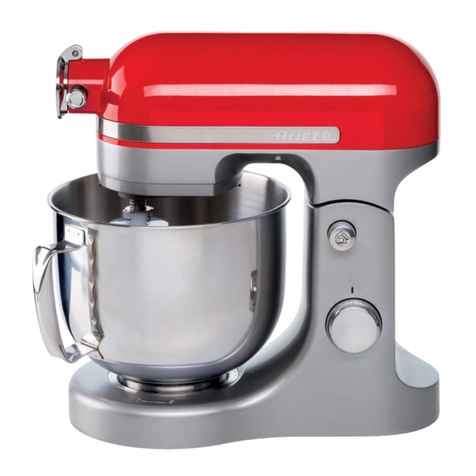
ARIETE
ARIETE 1589 User manual
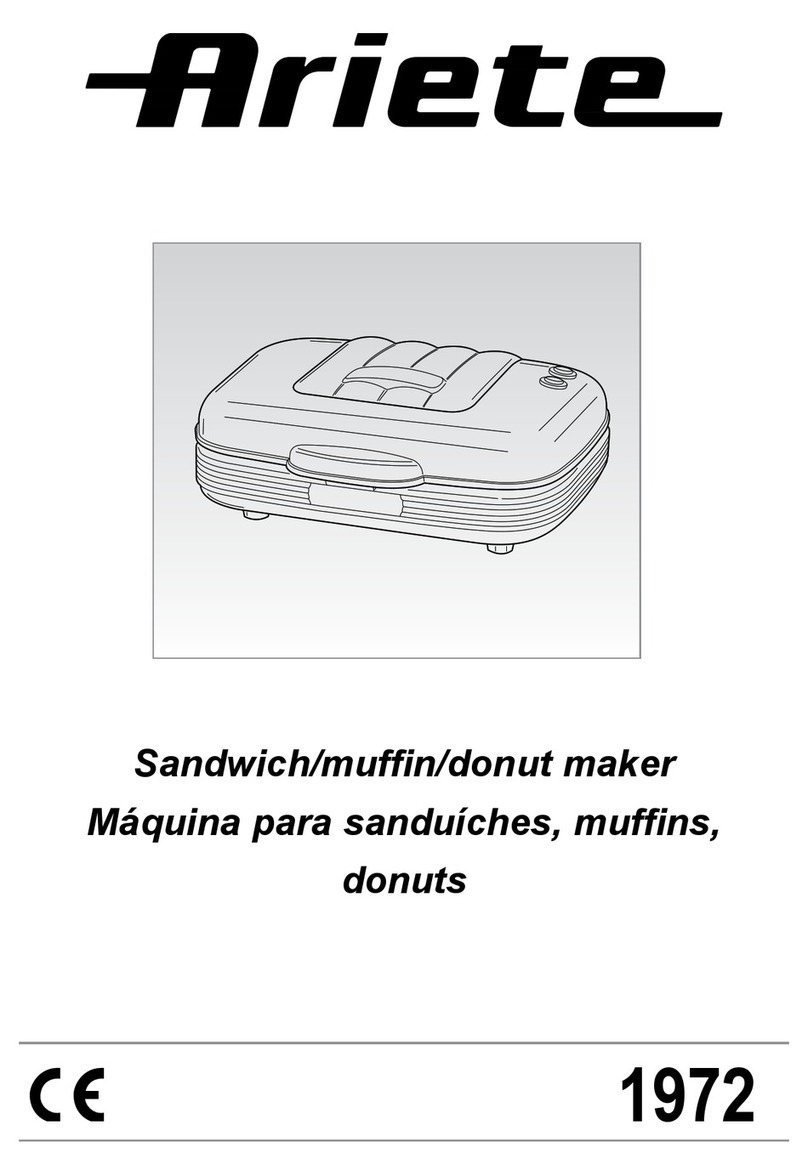
ARIETE
ARIETE 1972 User manual
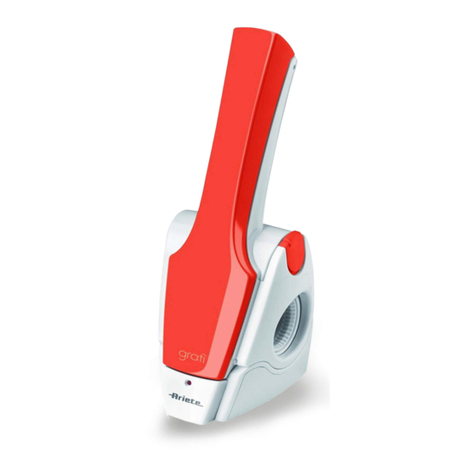
ARIETE
ARIETE Grati 447 User manual
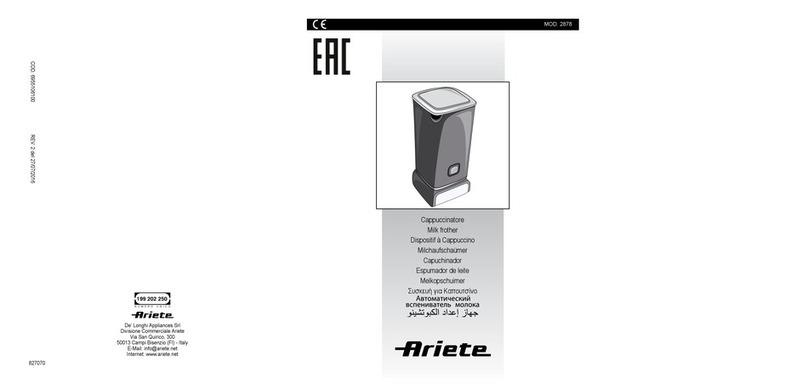
ARIETE
ARIETE ARC287803 User manual
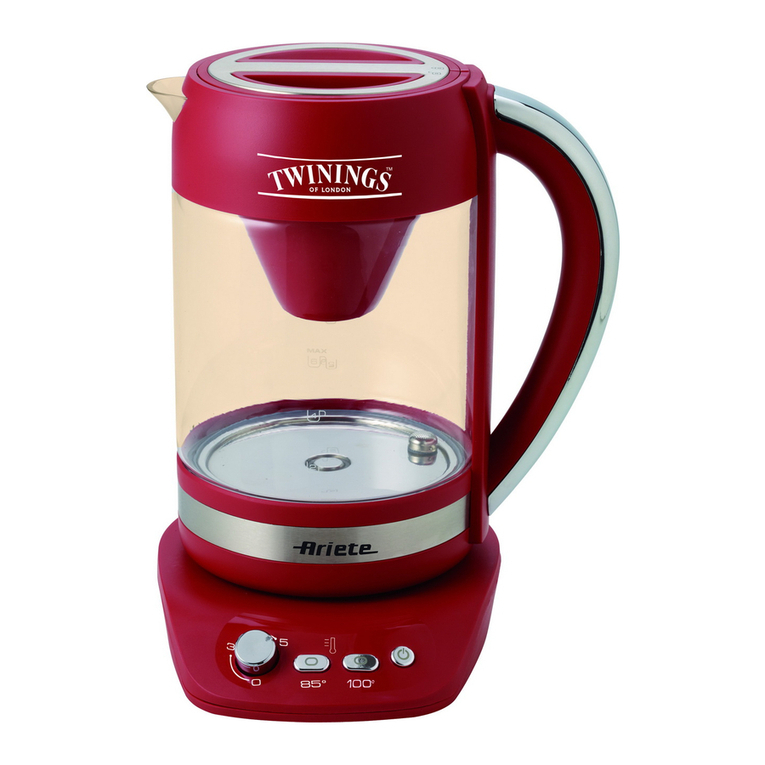
ARIETE
ARIETE TWININGS User manual
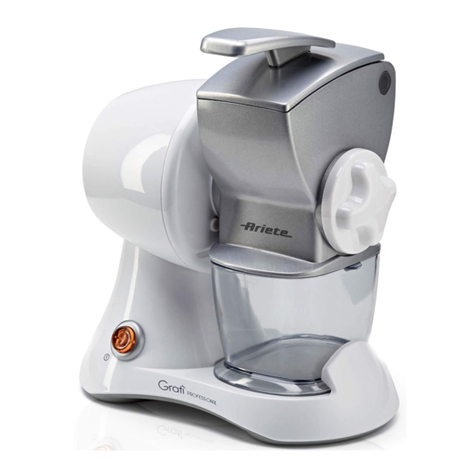
ARIETE
ARIETE grati PROFESSIONAL User manual
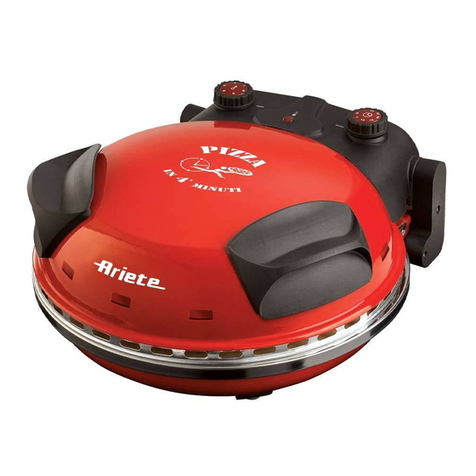
ARIETE
ARIETE 909 User manual
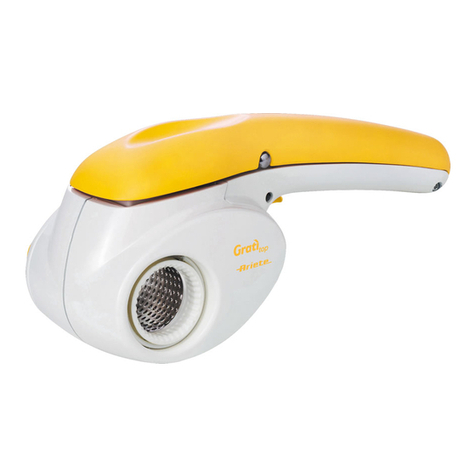
ARIETE
ARIETE Grati top 443/3 User manual

ARIETE
ARIETE Saladino 1789 User manual

ARIETE
ARIETE 4079 User manual
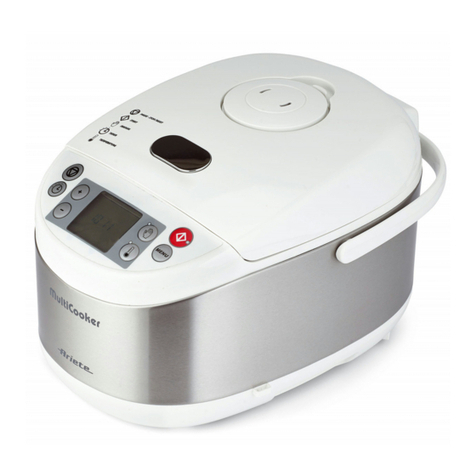
ARIETE
ARIETE 2941 User manual
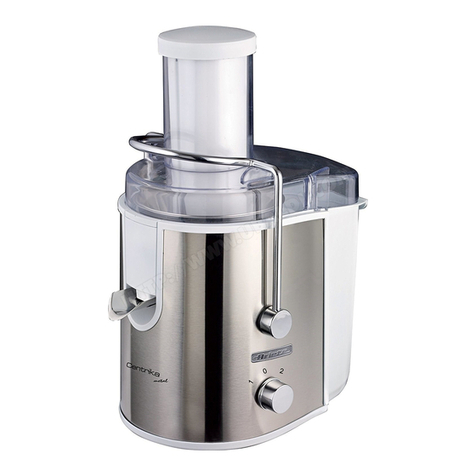
ARIETE
ARIETE Centrika metal 173/2 User manual
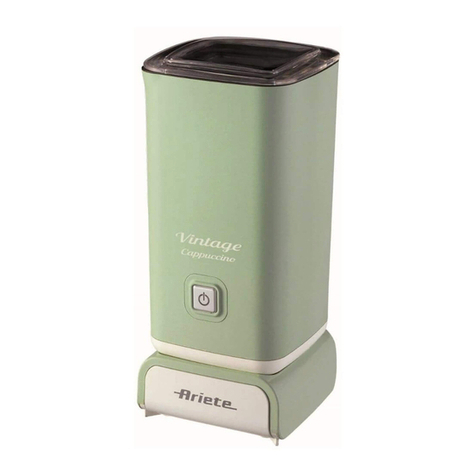
ARIETE
ARIETE 2878 User manual
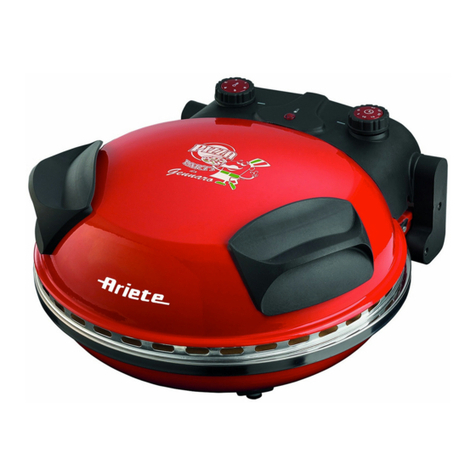
ARIETE
ARIETE Pizza Party Da Gennaro 905 User manual
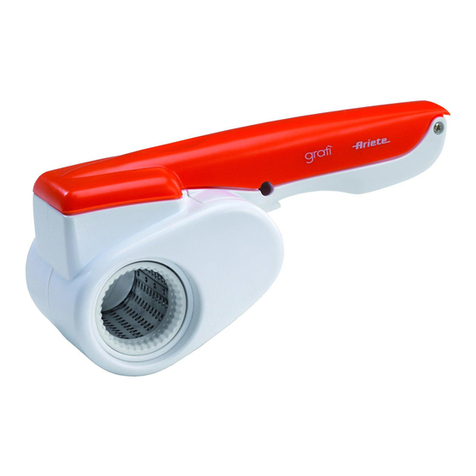
ARIETE
ARIETE 440 User manual
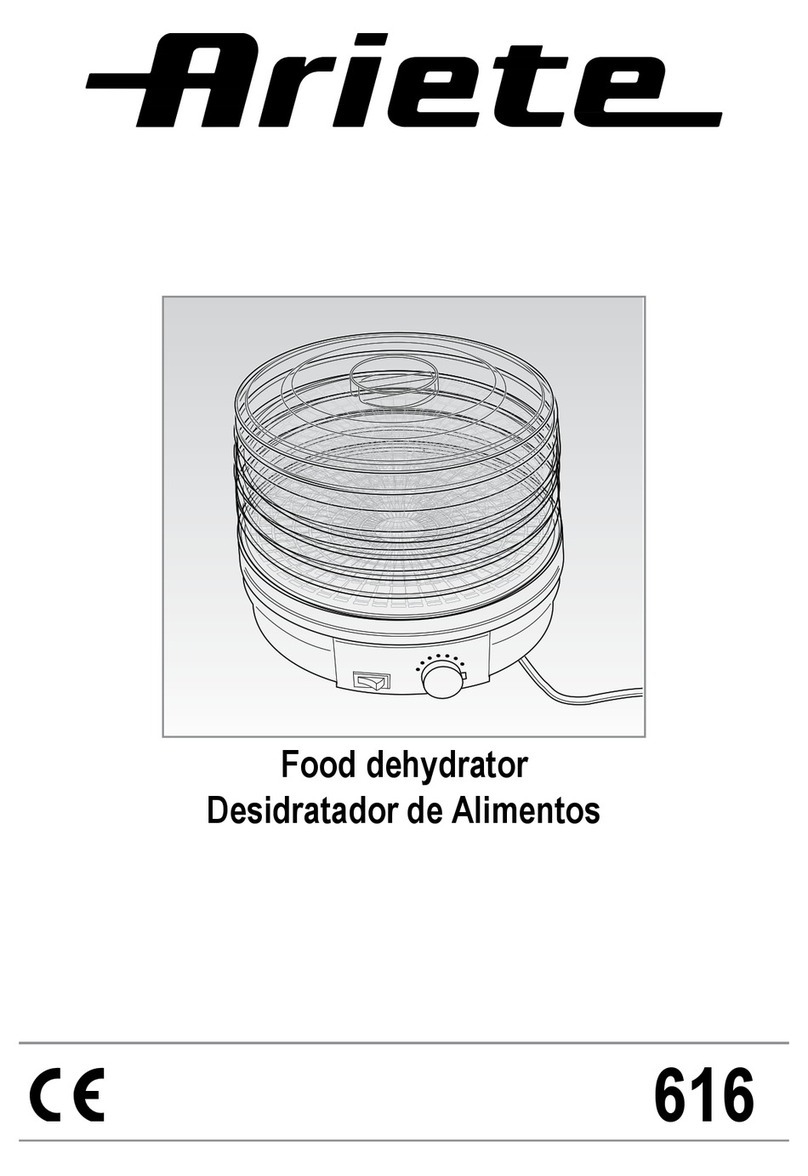
ARIETE
ARIETE 616 User manual
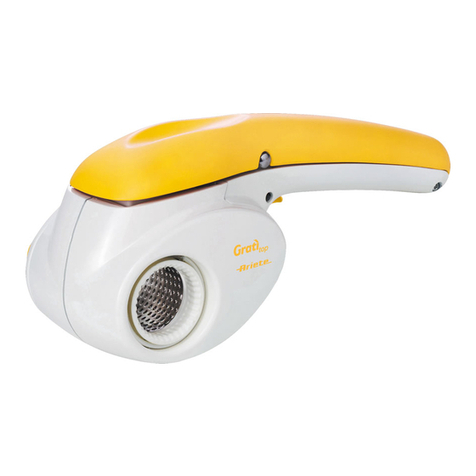
ARIETE
ARIETE GRATI User manual

ARIETE
ARIETE B-DRY User manual

ARIETE
ARIETE saladino 1791 User manual
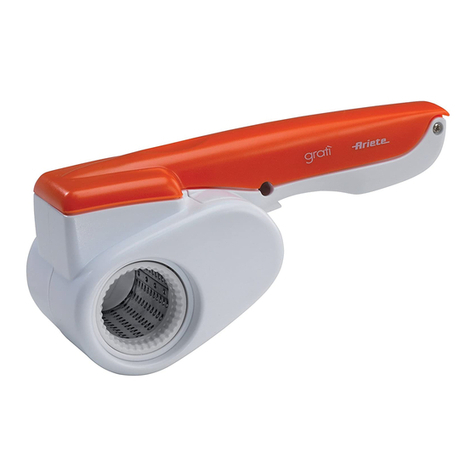
ARIETE
ARIETE Grati 440 User manual
